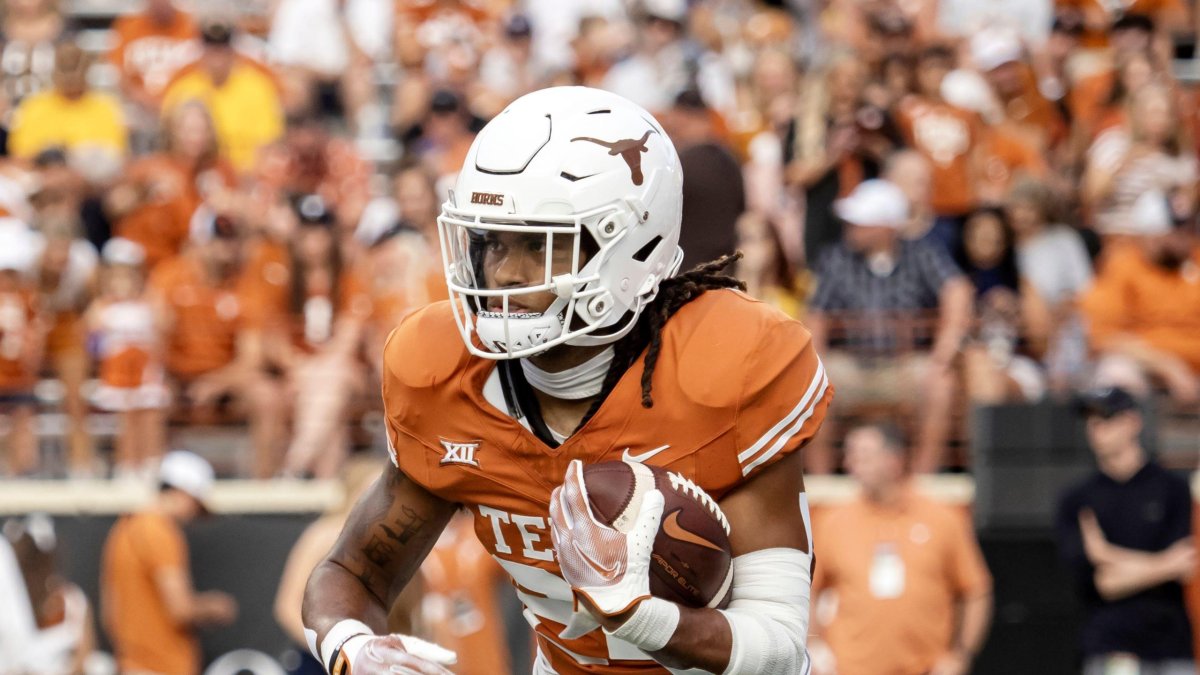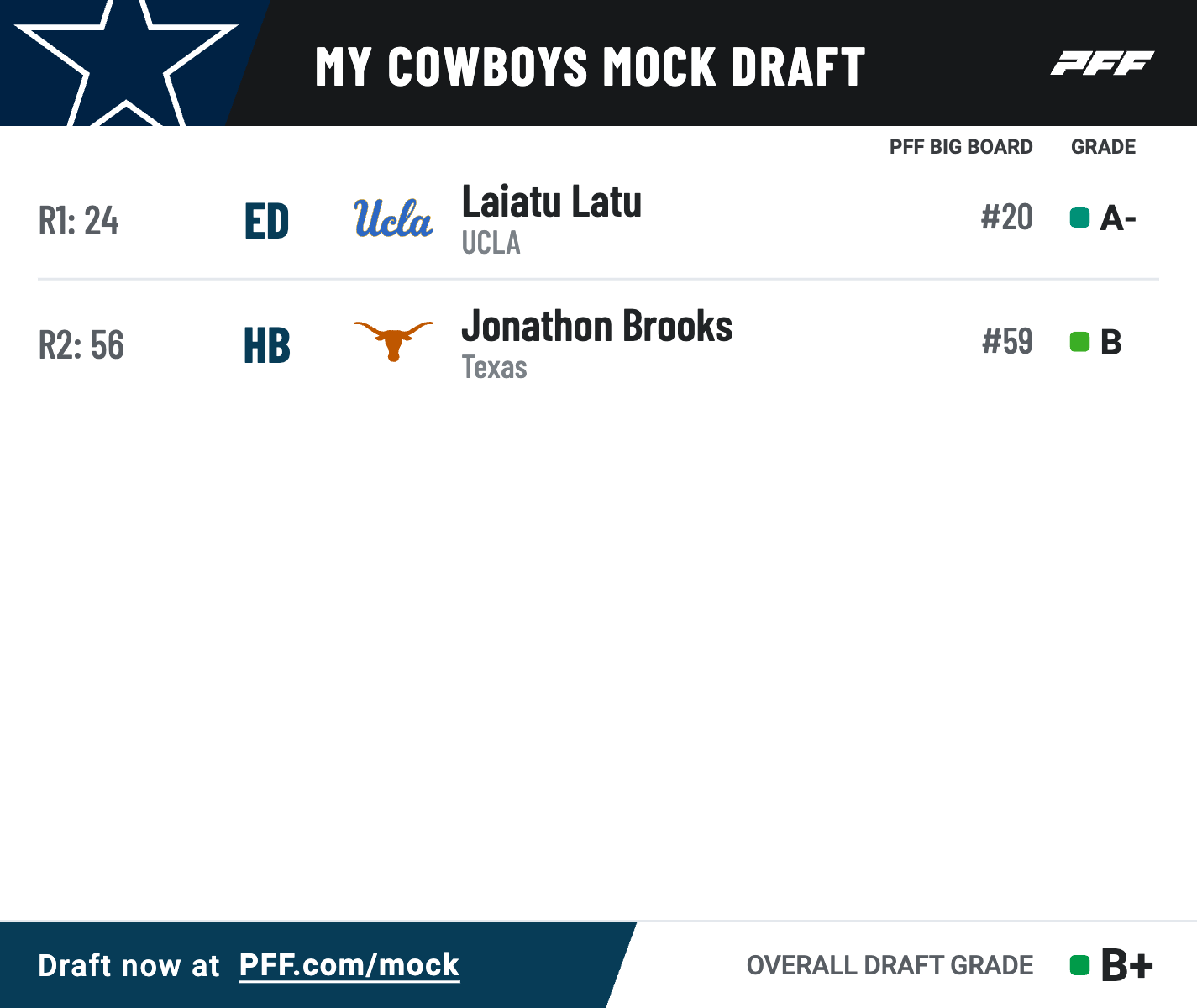• Texas RB Jonathon Brooks: Brooks may only be kept out of the first round by the knee injury he suffered last season.
• Michigan RB Blake Corum: The problem Corum is facing is that his 2022 injury had a demonstrably negative effect on his performance once he returned.
• Draft and trade for yourself: Try PFF's Mock Draft Simulator — trade picks and players and mock for your favorite NFL team.
Estimated reading time: 6 minutes
Click here for more draft tools:
2024 Mock Draft Simulator | 2024 Big Board | 2024 Draft Guide
2024 Player Profiles | 2024 Mock Drafts | NCAA Premium Stats
The NFL seems to hate this year’s running back draft class, judging by the contracts that were handed out to veterans in free agency and the urgency with which they were handed out. The Draft Community™ also does not like this class. The top running back on the consensus big board comes in at No. 60, almost two full rounds into the draft if teams stuck to that board in a few weeks.
I’m here to tell you that I think the class is significantly better than that, and the group will end up producing several impact players at the next level.
It is fair to say that this group lacks star power. Last season, the discussion centered around Bijan Robinson and how high you could reasonably take him in the draft given everything we know about the dependency of running back production. Essentially, he was such a special prospect, that the pre-draft question was how far can you bend the rules to draft him in the top 10.
After Robinson, there was also Jahmyr Gibbs who had elite speed and explosion and ended up being selected No. 12 overall, but the narrative on a given running back class tends to be produced simply from its top couple of players.
The class in 2022 was also questioned, but Breece Hall, Kenneth Walker, James Cook and Rachaad White ¯ the top four backs drafted that year — have all impressed so far to varying degrees and there have been several other productive players further down the class (Tyler Allgeier, Kyren Williams, etc.).
Draft classes that don’t have that star power may actually end up having hidden gems because they relegate backs to the areas of the draft that analytics data would suggest drafting them in the first place.
It’s not that running the ball isn’t valuable, it’s that it is so dependent on other things that drafting a back in the top 10, or even the first round, to try and fix or create a running game is just folly.
That doesn’t mean plugging a back into a good environment can’t create immediate production or a significant upgrade over what was there.
This class does seem to lack elite speed generally, but there will be productive playmakers from within it.
Jonathon Brooks, Texas
Brooks may only be kept out of the first round by the knee injury he suffered last season. He decided to declare for the draft anyway and get a head start in his pursuit of a second big money NFL contract, and it’s hard to argue that it’s the wrong decision even if it costs him some draft position. Brooks averaged 3.9 yards per carry after contact last season with 63 broken tackles and 16 breakaway runs of 15 or more yards.
Brooks is a high-end talent with an injury question mark.
Blake Corum, Michigan
Another player dealing with his own injury red flag is Michigan’s Blake Corum, but he is a year removed from the knee injury that he suffered. The problem he is facing is that the injury had a demonstrably negative effect on his performance once he returned. In 2022, Corum produced a 96.2 PFF grade, averaged 3.35 yards after contact per run and broke 73 tackles. The following year, coming off that knee injury, his grade slipped to 84.0 while he averaged only 2.4 yards after contact and broke 30 tackles. He was still a solid player, but he was no longer special.
If last year’s player was the version he will be in future, he will still be a solid NFL contributor, but if he rediscovers his 2022 form, he could be a difference maker in the NFL.
Jaylen Wright, Tennessee
One player who does possess that explosiveness and top-end speed is Tennessee’s Jaylen Wright. He averaged 6.3 yards per carry over his collegiate career and 7.4 last season for the Vols. Seventy-one of his 367 career carries went for at least 10 yards and his tape shows an impressive ability to set up blocks and actually influence the gaps he is trying to hit rather than simply run to daylight and try to exploit whatever space is there.
At 210 pounds, he is also bigger than many give him credit for and certainly has the size to be able to be more than simply an occasional change of pace at the next level. Fewer than 400 career carries in college though means that he has very little wear and tear on his body at a position where that can be paramount.
Trey Benson, Florida State
Arguably the most prototypical NFL prospect of the class, Florida State’s Trey Benson has measurables and a profile similar to that of Breece Hall from a couple of years ago. At 6-foot-1 and 221 pounds, Benson just dipped under a 4.4-second 40-yard dash at the combine and averaged almost 4.0 yards per carry after contact for his college career.
Like Wright, Benson also has very little mileage on the clock, averaging just 155 carries in each of his last two seasons and only toting the rock more than 20 times in a game once.
Benson is a classic profile of a back who will be more productive at the next level than he was in college if he lands in the right situation because all of the traits that teams look for are right there to be exploited.
The Rest
Audric Estime, Notre Dame
A big, powerful, and explosive back, Estime could easily emerge as the best back from this draft class over the next couple of years. He fixed his concerning 40-time at his pro day and broke 105 tackles over the last two seasons. Enters the NFL at just 20 years old.
Tyrone Tracy Jr., Purdue
A former wide receiver, Tracy doesn’t have the resume in the backfield of other prospects, but he averaged 4.44 yards after contact in his only full season working from the backfield and didn’t fumble the ball all season. He has incredible potential with a little development, and even if he remains a raw runner his physical ability makes him a phenomenal change of pace.
MarShawn Lloyd, USC
The USC product averaged 7.1 yards per carry last season and over 4.0 yards per carry after contact over the last two seasons in college. The only issue is trying to project that production into an offense that creates less wide-open spaces than Lincoln Riley’s USC system did for him. Lloyd is a mid-round prospect who could have immediate success if that playmaking ability translates.
Isaac Guerendo, Louisville
Guerendo ran a 4.33-second 40 time at the combine and did it at 221 pounds. He also had a 41.5-inch vertical jump and a three-cone time under 7.0 seconds. Those are elite NFL traits for a player who had 14 breakaway runs of 15 or more yards last season and has just 231 career carries in college.
Will Shipley, Clemson
A former top recruit, Shipley’s college career didn’t progress the way he would have liked, but his tape shows an incredibly natural runner with the football. At his pro day, he showed he has legitimate NFL tools with a sub 4.4 40 time and a 38.5-inch vertical. He broke 111 tackles in 526 college attempts.
Dillon Johnson, Washington
There are few things that Dillon Johnson doesn’t do well, and while he may not be special at anything, there are productive NFL backs that fit into that very same bucket. Johnson is an excellent sleeper candidate to have success at the next level.





 © 2025 PFF - all rights reserved.
© 2025 PFF - all rights reserved.